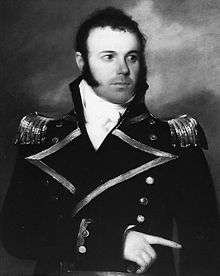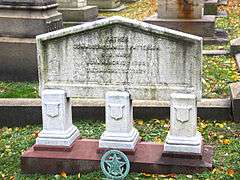Daniel Patterson (naval officer)
Daniel Todd Patterson (March 6, 1786 – August 25, 1839) was an officer in the United States Navy during the Quasi-War with France, the First Barbary War, and the War of 1812.
Daniel Todd Patterson | |
|---|---|
 | |
| Personal details | |
| Born | March 6, 1786 Long Island, New York |
| Died | August 25, 1839 (aged 53) Wilmington, Delaware |
| Relations | Walter Patterson (uncle) Thomas H. Patterson (son) Carlile Pollock Patterson (son) |
| Military service | |
| Allegiance | |
| Branch/service | |
| Years of service | 1799–1839 |
| Rank | Captain |
| Commands | New Orleans Squadron Constitution Mediterranean Squadron Washington Navy Yard |
| Battles/wars | Quasi-War |
Early life
Patterson was born on Long Island, New York.[1] His father, John Patterson, was a younger brother of Walter Patterson, who was the first Royal Governor of Prince Edward Island (then named St. John's Island). John and Walter came to America in the 1750s from Ramelton or Rathmullan, County Donegal, Ireland, and served in the British Army in the French and Indian War.
Daniel Patterson's mother, Catherine Livingston (1744–1832), was a daughter of the "Third Lord of the Manor" of Livingston, Robert Livingston (1708–1790) (also see Livingston family). James Duane, a respected lawyer, patriot, New York politician, and judge, was Daniel Patterson's uncle (by marriage to Patterson's aunt, his mother's sister Mary Livingston).
Naval career
As acting midshipman, he joined the sloop of war Delaware, June 11, 1799, to cruise against French privateers and warships in the West Indies to August 1800. Appointed a midshipman on August 20, 1800 (warrant subsequently altered to take rank from date of his original entry, June 11, 1799). After the war, was one of the midshipmen retained in the Navy under the Peace Establishment Act, signed by President Adams in one of his last official acts, on March 3, 1801. On close of the Quasi-War with France, he resumed nautical studies, then had blockade duty off Tripoli in Constellation and Philadelphia. On October 13, 1803 he fell prisoner upon capture of Philadelphia, commanded by William Bainbridge, when the vessel ran aground on an uncharted reef of the coast of Tripoli, and remained a captive of the Barbary pirates until the American victory over Tripoli in 1805.[2]
Upon returning home, he spent much of his following years on station at New Orleans, Louisiana, where he took command after the outbreak of the War of 1812. On September 16, 1814, Patterson raided the base of the pirate Jean Laffite at Barataria Bay, capturing six schooners and other small craft. In that same month, he refused Andrew Jackson's request to send his few naval units to Mobile Bay where Patterson knew they would be bottled up by a superior British fleet.
Foreseeing British designs against New Orleans almost two months before their attack, Patterson, not Jackson, was the first to prepare to defend the city. The American victory at the Battle of New Orleans resulted as much from his foresight and preparations as from Jackson's able fighting. His little fleet delayed the enemy until reinforcements arrived, then gave artillery support in defense of the entrenchments from which Jackson was never driven.
Patterson, highly commended by Jackson, received a note of thanks from Congress, and was promoted to Captain on February 28, 1815. Patterson remained on the southern stations until 1824. Because of failing health, Thomas Macdonough relinquished command of USS Constitution whereupon Patterson then assumed command and became fleet captain and commander of this flagship in Commodore John Rodgers' Mediterranean Squadron.

Returning home in 1828, he was appointed one of the three Navy commissioners. He commanded the Mediterranean Squadron from 1832–1836. He then took command of the Washington Navy Yard in 1836, an office he held until his death at Wilmington, Delaware, August 25, 1839. Daniel Todd Patterson and his wife are buried in Congressional Cemetery, Washington, D.C.
The Life of Gould, an Ex-Man-of-War's Man, by Roland Gould (1867), noted on a website of the Navy Department Library at the Washington Navy Yard, purportedly contains a first-person account of the death of Commodore Patterson.
Rank
Although Patterson is properly called a "Commodore", during his years in the Navy this was not one of the hierarchical "line" ranks. Instead, "Commodore" applied to any officer in command of a fleet of two or more ships, regardless of the officer's "line" rank at the time, and regardless of whether the officer also held the dual role of commanding officer of one of the ships in the fleet. Thus Patterson was a Commodore at the time of the Battle of New Orleans because he commanded a fleet of ships, even though he was not promoted to the "line" rank of Captain until after the battle. He again became a Commodore when in command of the Mediterranean Squadron. Patterson was never an Admiral because in his day the highest "line" rank in the US Navy was Captain; the title Admiral was felt to smack of aristocracy and royalty, and did not become a "line" rank in the US Navy until the Civil War.
Family
His children include Carlile Pollock Patterson, Thomas Harmon Patterson, Eliza Catherine Patterson – wife of George Mifflin Bache, Sr., and George Ann Patterson – wife of David Dixon Porter.
Patterson's wife, George Ann Pollock of New Orleans, is worth noting because her parents, George Pollock and Catherine Yates Pollock, and her maternal grandparents, Richard Yates and Catherine Brass Yates, had their portraits painted by Gilbert Stuart, in 1793–1794. All four of the portraits are in the permanent collection of the National Gallery of Art, Washington, D.C. The portrait of Mrs. Richard Yates (Catherine Brass Yates) is particularly well-known.
Richard Yates and his son-in-law George Pollock were successful merchants in New York, with their firm Yates & Pollock. But they were driven out of business around 1800, when their ships and cargoes were seized by French privateers during the Quasi-War. Pollock moved to New Orleans, where his uncle Oliver Pollock, a financier of patriot operations during the Revolution, had been in business. Commodore Patterson's great-great-great-grandson, Edward Sisson,[3] is currently writing a historical novel focusing on this part of Patterson's & Pollock's lives.
Namesakes
Three ships in the United States Navy have been named USS Patterson for him.
There is a Patterson Drive in New Orleans, on the west bank of the Mississippi River, close to the levee, which in all likelihood was named for Commodore Patterson because of his War of 1812 service there.
Bibliography
- Fredriksen, John C. (1999). American Military Leaders: A-L. v. 2. M-Z.
ABC-CLIO, California. p. 926. [ Url]
- Maclay, Edgar Stanton (1894). A history of the United States Navy, from 1775 to 1893.
D. Appleton & Company, New York. p. 647. Url
- MacDonough, Rodney (1909). Life of Commodore Thomas Macdonough, U. S. Navy.
The Fort Hill press, Boston, Mass., 1909. p. 303. Url
- Walker, Alexander (1856). Jackson and New Orleans. An authentic narrative of the memorable achievements of the American army, under Andrew Jackson, before New Orleans, in the winter of 1814, '15.
J. C. Derby. p. 411. Url
See also
- Bibliography of early American naval history
References
- Fredriksen, 1999 p.566
- Fredriksen, 1999 p.566
- "YouTube – sissoed's Channel". youtube.com. Retrieved 18 October 2010.
- This article incorporates text from the public domain Dictionary of American Naval Fighting Ships. The entry can be found here.
